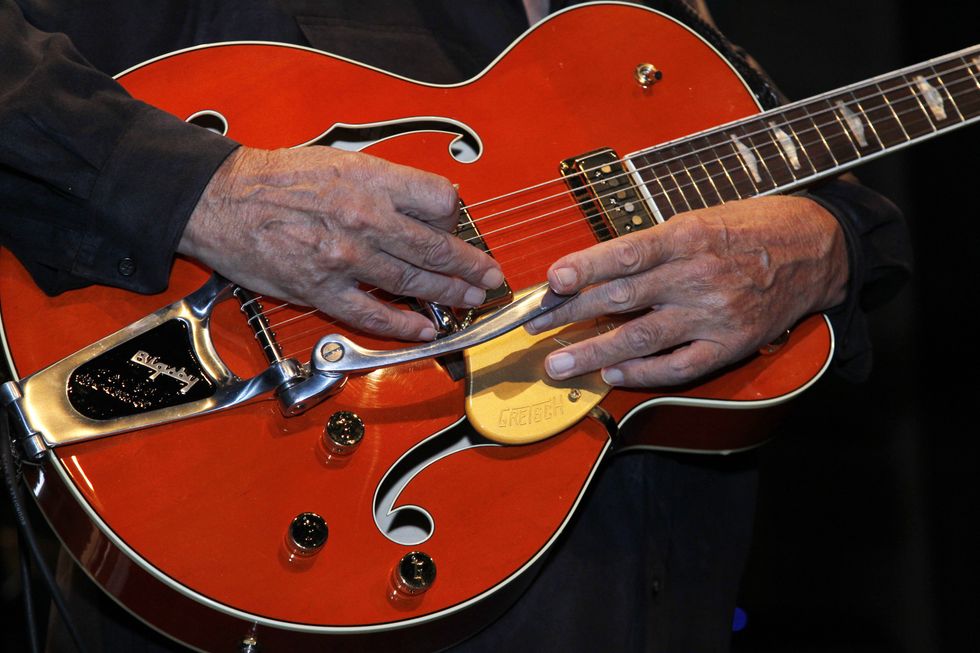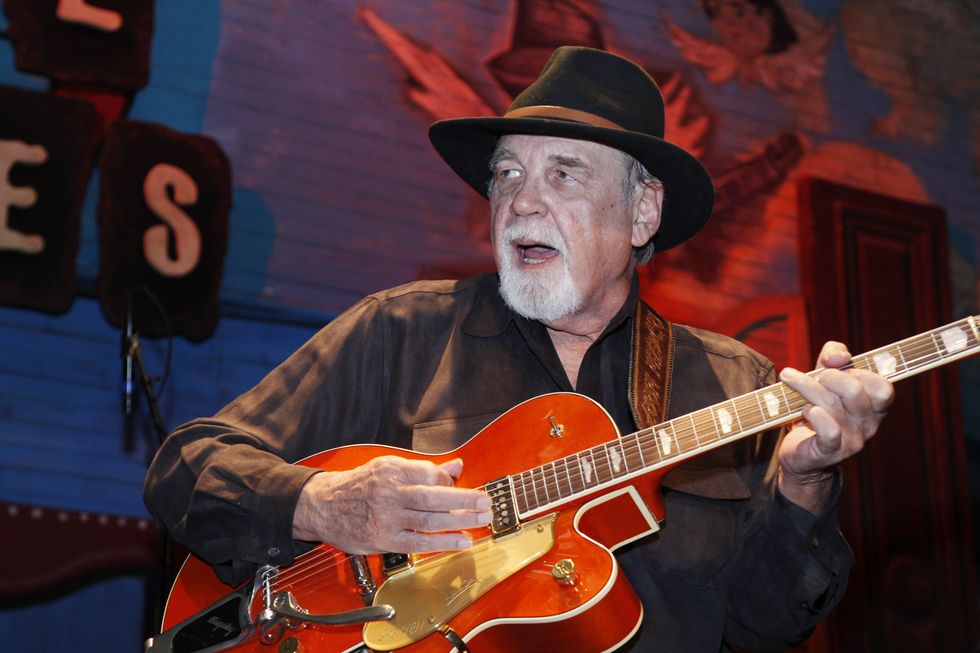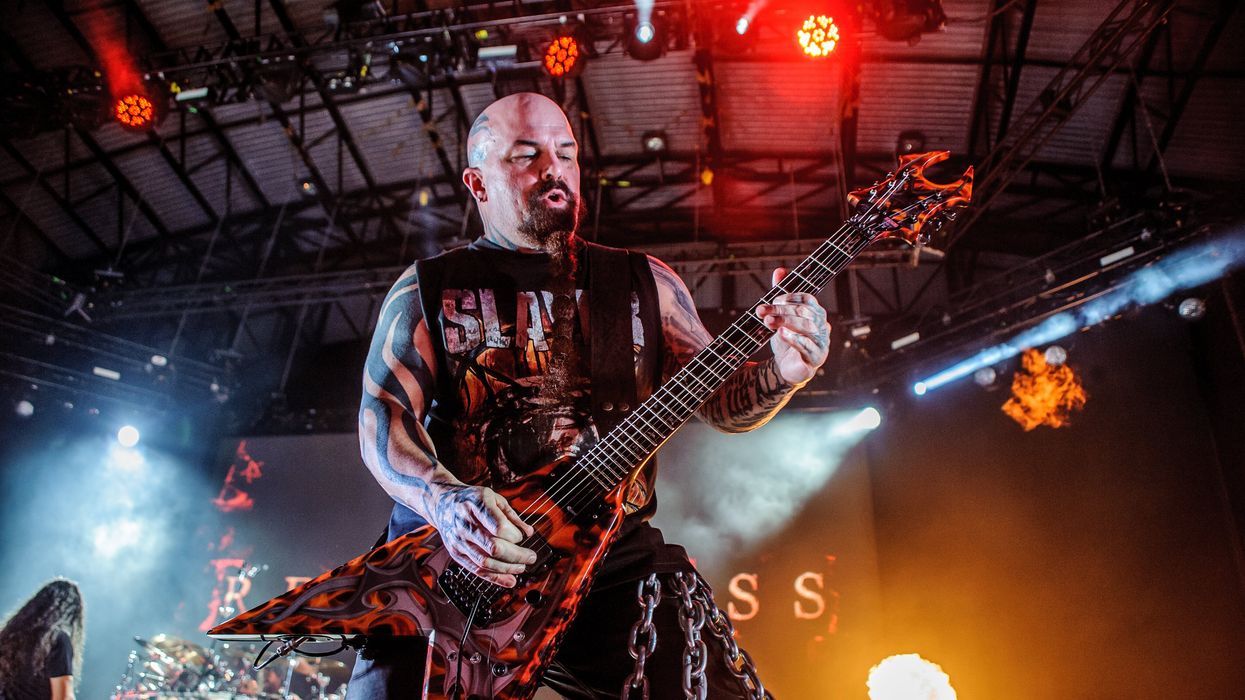Instrumental rock arrived with a growl and a twang in 1958. The growl was from Link Wray’s fierce “Rumble,” which put distorted guitar on the pop charts—at No. 16—for the first time. The twang was the low, reverb-bathed, tremolo-burnished sound of Duane Eddy’s Gretsch 6120 on “Rebel Rouser,” which reached No. 6 on Billboard’s Hot 100 in May.
For the next 66 years, Eddy and his 6120 were inseparable, and he remained the undisputed “King of Twang,” releasing 21 albums over the next nine years that influenced the sound of guitar, from the Shadows and the Beatles to John Fogerty and Bruce Springsteen to the composer Ennio Morricone, whose famed spaghetti Western soundtracks often employed a 6-string approach—big tones, big melody—plucked from the Eddy handbook.
The master of twang died on Tuesday, April 30, of complications from cancer at a hospital near his home in Franklin, Tennessee. He was 86 years old and is survived by his wife, Deed, and daughter, Jenni Eddy. At his passing, there was an outpouring of tributes from members of the guitar community. Springsteen posted a video remembering Eddy on Instagram, noting “without Duane, there’s no this,” before playing the riff from “Born to Run” on a Gretsch hollowbody. And Fogerty called Eddy “the first rock ’n’ roll guitar god.”
Eddy was born in Corning, New York, on April 26, 1938, and was playing guitar by age 5. After his family moved to Coolidge, Arizona, he formed his first band with high school friend Jimmy Delbridge, called Jimmy and Duane. They were discovered by local disc jockey Lee Hazelwood, who would become a famed singer-songwriter and producer. Hazelwood produced Eddy’s first single, 1955’s “I Want Some Lovin’,” and continued to work with Eddy into 1960.

Eddy wanted a Gretsch, in part, because of its Bigsby whammy bar. As he suspected, the device became an important part of his twangy sound.
Photo by Joseph A. Rosen
By ’55, 16-year-old Eddy had already begun to formulate his own style, picking out melodies on his guitar’s bass strings. Soon he would acquire his first 6120. Eddy used the instrument’s Bigsby vibrato and his low tone, saturated with reverb and tremolo, and picked the strings about four inches above the bridge to complete his distinctive sonic profile. Another element was his choice of 2x12 Magnatone amps, which he had hot-rodded to 1x15s with the output power goosed up from 65 to 100 watts. As legend has it, Eddy became so devoted to reverb that he once acquired a 2,000-gallon water tank to use as an echo chamber and placed an amp inside it during a recording session.
In 2018, when journalist Michael Ross profiled Eddy for Premier Guitar, Eddy told Ross the story of how he acquired the first of his beloved Gretsch models: “After we moved to Arizona, I bought a goldtop Les Paul for $75 in a hardware store in a little town south of Phoenix in about 1954. A guy in town made these orange-crate amps with a 12" speaker and chicken wire in the front. I used that for the first couple of years. Then, around 1957, I was at Ziggie’s Music in Phoenix looking at guitars. I looked at a White Falcon, but it was too expensive and didn’t play that great. They brought out an orange 6120 and handed it to me. It sat in there just so beautifully and the neck was a dream. I thought I would come back with my father to cosign for me. I picked up my Gibson and started out. Ziggie [Zardis] said, ‘Where you going?’ I replied, ‘I’ve got to get some dinner and go to work.’ ‘Don’t you want to take this with ya?’ he said. I said, ‘We haven’t signed anything.’ He told me, ‘It’s your guitar, take it. When your dad gets back, have him come by and sign the paperwork.’ I left there a happy camper. My dad didn’t get there for about three months.” [laughs]
“A guy in town made these orange-crate amps with a 12" speaker and chicken wire in the front. I used that for the first couple of years.”
Between 1958 and 1962, Eddy and his 6120 sound became embedded in American popular culture. On radio, “Rebel Rouser,” “Ramrod,” “Cannonball,” “Forty Miles of Bad Road,” and “Because They’re Young” became staples. And on TV, he contributed the theme to the hit show Have Gun — Will Travel (the song is 1957’s “The Ballad of Paladin,” with vocalist Johnny Western), then covered the instrumental title number Henry Mancini composed for the detective series Peter Gunn, which reached No. 27 on the charts. When Eddy revisited “Peter Gunn” with the British avant-pop band Art of Noise in 1986, it once again returned to the charts with his eminently twangy guitar in the lead. The recording was awarded a best instrumental rock Grammy the next year.
Although Eddy is mostly remembered with the 6120 in his hands, Guild made him a signature model in 1961, based on their T-500 model, and he became the first rock guitarist with an instrument bearing his name. The company made both a DE-400 and a DE-500, the latter with fancier appointments. These guitars are quite rare today, and priced between $4,000 and $6,000 on the vintage market. In later years, however, he returned to the 6120 both live and in the studio.
By 1967, when he cut the albums Tokyo Hits and The Roaring Twangies, Eddy’s musical approach had fallen from favor. But his reverberating guitar sound and tough picking was not entirely out of step with what was happening in evolutionary rock at the time. Replace Eddy’s quieter melodicism with angularity and distortion, and there’s a sonic correlation with Syd Barrett’s playing on Pink Floyd’s debut album, Piper at the Gates of Dawn, Jefferson Airplane’s Surrealistic Pillow, and Jimi Hendrix’s Axis: Bold as Love.

Duane Eddy was among the historic American music makers who played at the Ponderosa Stomp in New Orleans in 2014.
Photo by Joseph A. Rosen
“They brought out an orange 6120 and handed it to me. It sat in there just so beautifully and the neck was a dream.”
But at that point, Eddy took a 20-year break from recording as a leader. He returned after the success of his collaboration with Art of Noise, with an album called Duane Eddy. Despite being produced by Paul McCartney, Jeff Lynne, and Ry Cooder, and featuring George Harrison, McCartney, Cooder, David Lindley, James Burton, and Steve Cropper, the disc slipped into obscurity. Eddy also moved to Franklin, Tennessee, at about the same time, and played on the album Thirteen, by the legendary country singer Emmylou Harris. His final album was 2011’s Road Trip, where Eddy paid tribute to Django Reinhardt, Chet Atkins, and other influences. It also failed to catch fire.
During the past decade, Eddy also did some recordings with the Black Keys’ Dan Auerbach, performing on the 2016 Auerbach-produced solo album by the Pretenders’ Chrissie Hynde, Alone, and adding guitar to “Livin’ in Sin” on Auerbach’s 2017 solo album, Waiting on a Song. Coincidentally, one of the more interesting contemporary purveyors of the Eddy-influenced twangy, reverberant approach is another Auerbach-produced band, Hermanos Gutiérrez.
Today, Eddy’s sound continues to literally reverberate in guitar-based music. So do the words he shared, reflecting on his technique, with U.K-based music journalist Matt Parker in 2018: “You have to have your own sound, do it with authority, and let it all hang out. If you do that, you communicate with your guitar.”
Duane Eddy "Rebel Rouser"
Duane Eddy and his band mime a play-through of their hit “Rebel Rouser” for TV cameras in 1958.

















![Rig Rundown: Russian Circles’ Mike Sullivan [2025]](https://www.premierguitar.com/media-library/youtube.jpg?id=62303631&width=1245&height=700&quality=70&coordinates=0%2C0%2C0%2C0)








